Sandy Wright's Blog, page 10
November 30, 2018
Ripples of Connection
 I’ve been thinking a lot this week about the concepts of “spirit” and “connection.”
I’ve been thinking a lot this week about the concepts of “spirit” and “connection.”What evokes the sensation of connection for you? Some people may feel connected to nature while walking in the forest, or sitting silently beside the ocean. Others may experience it while performing music, or writing, or creating art, or kneeling to pray. Many others gain connection through making love, sharing a meal with family, or laughing with friends.
While we might find many of these activities pleasurable, it is the presence of this sensation of connection to your own core, or to something larger or beyond yourself, that differentiates a pleasurable experience from a spiritual experience. Only you can tell which things are simply, if delightfully, pleasurable and which things hold that unique sensation of connection.
“Wakan, Wakan, every creature
Wakan, Wakan, every rock.”
One of the basic tenants of Native American belief, and one of its most beautiful, is that everything in life has a spirit and is Wakan, or sacred. Our First People honor the primal force of life, the stream of existence in which each of us swims.
In witchcraft, when we look within ourselves to seek the nature of spirit, we often use the concept of “As above, so below. As within, so without.”
The Dalai Lama used the analogy of a pebble, dropped in the middle of a pond, whose ripples flow outward all the way to the edges of the water. Unfortunately, people sometimes swim around in their little spot of water, largely unaware of the larger cosmos in which they are involved, and the miracles it can bring them. But you have to wake up and stretch your feathers to see the whole pond!
Jean E. Charon, a French physicist, philosopher and author of the book, The Spirit: That Stranger Inside Us, says, “There are microscopic individualities inside every human. They think, they know, and (they) carry Spirit in the Universe.” He calls these bits of intelligence eons, also known as electrons. “An electron that was successively part of a tree, a human being, a tiger, and another human being will thus remember for all time the experiences it has collected during these different lives. The electron will maintain within itself all of its experiences as tree, as human being No. 1, as tiger, and as human being No 2, to whose organisms it belonged.”
Wow!
The ancient Celts had a word for this concept, tuirigin (TOOR’ghin), a very precise word for which there is no English equivalent. The nearest we can get to a translation is, “a circuit of births,” according to Caitlin Matthews, a Celtic historian. She says it’s, “not quite the same as reincarnation. In tuirigin, the soul or spirit moves between the otherworld and this world in a series of journeys.”
The Gaelic word for God is Cruithear, which means ‘creator’ or ‘shaper,’ and the ancient people in Scotland, the Picts, were referred to as the Cruithne, “people of the shapes.” Roman accounts, as well as Scottish oral tradition, tell us that the bodies of these ancient ones were covered in elaborate blue tattoos of various animals and other shapes. According to Matthews, it was their way of honoring the sacred world that had shaped them.
How many of us live our lives as ambassadors of the sacred spirit in all things, be it human, plant or animal? If we do not remember our own sacred standing, we may do things that are not in alignment with ambassadorship. Rather than fostering harmony and living an inspirited life, we may instead create discord and destruction.
What if the soul that is our current self came into this lifetime for a specific purpose? First, however, we must recognize that purpose and consciously act upon it.
So this week, I turn my attention inward to my personal work. I take to heart the Dalai Lama’s analogy of a pebble dropped in the middle of the pond, whose ripples flow outward all the way to the edge. My actions ripple outward, having impacts I may never know.
For the rest of this year, whenever I find myself in a crowded place, whether it’s a football stadium, a Yule ritual, a movie theatre, football stadium, or driving in traffic, I’m going do the following activity: I will look at all the different people and whisper to myself, “Every man, my brother. Every woman, my sister. Every crying child, my child. Every old woman or man, my grandmother or grandfather. Every wounded soul, my soul. Every animal and creature, under my care.”
Will you join me in this exercise in conscious connection?
In my mind, your spiritual path makes no difference. The witch’s path, the tribal path, the Buddhist path, the Christian path. Your path. All of us make ripples that radiate out around us. Let’s make the biggest loving ripples we can.
Blessed Be.
Published on November 30, 2018 18:31
November 22, 2018
Thanksgiving Goddess

The Queen was quite pleased with herself. It was the Monday before Thanksgiving and she planned to spend the next four days getting ready for her guests. First, she swept the floors and mopped them with magical herb water, singing, “Out with the negative and stale, in with freshness and prosperity!” She could almost feel the house breathe a sigh of contentment when she finished. Next, she bleached her sink and deodorized the garbage disposal and trash can with fresh lemon from her tree in the garden. She cleaned her cabinets and counter tops with lavender water. The room was gleaming and spotless.
On Tuesday, she thawed her turkey and plunged it into an herb-infused salt brine bath overnight to be sure it would be tender and flavorful. This year, the bird was so big--nearly 25 pounds--she’d had to go out and buy a metal tub to accommodate the chubby sucker. Of course, the tub leaked, so she ended up lining it with a trash bag and making another batch of brine to replace the first one which was now soaking into the back lawn. She hoped her husband wouldn’t notice the big patch of dead grass encrusted in a salt ring. It was pretty hard to miss, but she was going to plead ignorance, no matter how much he questioned her.
She was almost finished preparing all her dressing ingredients to mix and stuff inside the turkey. Of course, her favorite, the one with cornbread, apples, currents, onion and mushrooms, she’d have to make separately the day before. Her daughter-in-law was allergic to mushrooms, couldn’t stand the things, and refused to eat at the Queen’s house if she had fixed anything with mushrooms that day. As she diced onion and celery, the Queen’s mind wandered to other mushroom recipes. Ones where she might be able to completely mask the ingredient. A small smile curved the edges of her mouth upward, and she pulled her red stock pot from atop the refrigerator and started a batch of home-made stock. “Vegetable soup will be perfect tomorrow. It’s forecast to rain, and soup always tastes better when it’s rainy outside.” By the time the stock was bubbling, the Queen was humming happily.
Wednesday she got down on her hands and knees and scrubbed the kitchen floor grout until it was the same color as the tiles. She timed herself: twenty squares cleaned in an hour. Two hundred and fifty squares in the kitchen and entry way. No wonder she hadn’t cleaned them in years. By the time she finished, it was dark out. She could barely stand and her back was in spasm all night. She’d forgotten to eat her soup. But boy, that floor looked like new.
She got up before dawn Thanksgiving morning to stuff the turkey and get it in the oven. Almost screamed when she squatted down and shoved that twenty-five pound roaster pan of slimy poultry into the oven. Next house, she was buying a built-in oven she didn’t have to bend in half to use. She took some ibuprofen with her coffee. No time for breakfast, she had pies to bake. Oh, and that second pan of mushroom-free stuffing.
The Queen ironed her best table cloth, the linen one with scalloped lace edges. It had been a wedding gift, but she rarely used it. The stains were so hard to get out of linen. But today she thought, “It’s Thanksgiving. My loving family will all be here. My house looks beautiful. We have a delicious meal. I am so thankful for all this abundance for myself and my loved ones.” She was so happy, in fact, that she set the table with her best china and crystal.
The house smelled delicious already. With all the wonderful scents in the kitchen, her daughter-in-law would never know she made that mushroom dressing.
She added a vase of bittersweet to the dining table and lit candles in the front windows. Feeling contented, she headed the bathroom to shower and dress for dinner.
While she was in the shower, the Prince arrived, home for the long weekend from Flagstaff.
“Mom, I’m home,” he hollered. He dumped the soft drink from his car in the gleaming sink, leaving it brown. Peeking into the oven, he checked the turkey. It smelled good but it wasn’t done. So he rummaged in the pantry for chips and salsa, dripping salsa on the counter as he filled himself a bowl, and leaving the dirty dishes in the living room when he went to his room to play video games.
Then the King arrived. He dumped a pile of junk mail on the table, next to her vase of bittersweet. He’d been collecting it in his car all week and decided this was the day to clear the passenger seat in case they used the car that night.
The cat jumped up on the table to greet him, and knocked over one of the good wine glasses, sending it to the floor in an explosion of shattering crystal.
The Queen was out of the shower by then. The king joined her in the bathroom, giving her a quick peck on the cheek and grabbing a quick feel-up. “Uh, don’t worry about the broken glass, honey, I’ll clean it up in a few minutes.” Then he headed into the next room to turn on the football game, leaving a trail of muddy boot prints on her pristine floor. It was raining outside.
The Queen stumbled through the house in disbelief.
NO! I've only been gone for thirty minutes. She sank into a chair, feeling numb. It was the first time she had sat down in four days, except to sleep.
The front door opened and daughter-in-Law popped her head in. “Do I smell mushrooms?”
Several newspapers lay amongst the pile of discarded mail. The tired Queen picked up the most recent one.
“Screw the Thanksgiving goddess. I’m going to the movies.”
Happy Thanksgiving to all. And may your day go better than this!
Published on November 22, 2018 00:38
November 16, 2018
Crone Forged in Fire
 Winter is coming.
Winter is coming.My blood is thin and my bones are cold in the evenings. My animals no longer stretch out on the cool tile to sleep. Instead, they curl their tails around themselves, and tuck their noses into warm blankets.
The coats on their backs are changing also; every cat and hound has become fluffy.
But I have no fur, so I sit in my chair covered in the red Christmas blankets I pulled out of the chifferobe this week. I often use the winter when I need to move through some of the smaller changes in life, allowing the Wheel of the Year to pull me down into the dark, where I can do my deep work. It pulls me out again in the spring, armed with a clearer plan for the year, resolutions made, and to-do lists quantified and prioritized.
But the last three years, I haven’t done a winter hibernation.
 The fires of change roared through my life in 2015, burning many of my hopes and dreams in its path.
The fires of change roared through my life in 2015, burning many of my hopes and dreams in its path. Like the wildfires now raging in California, I didn’t see the fire coming. There was no chance to sort through life, decide what was most important to keep, and let the rest go up in flames. Instead, the destruction was uncontrolled, and painfully destructive, as if the fire recognized those things in the forefront of my mind, the things I held most dear, and demolished them first.
I felt hopeless, and spent much of the next year in despair. Finally last year, I began to rebuild. Hopes. Future plans. Newer, stronger relationships, forged from the lessons learned.
Now I’m ready for another, albeit controlled, burn. This month, before I descend into my psyche for the winter’s deep work, I’m consciously shaping some fire imagery to use in some planned spellwork for change.
 rst, the image of fire to create an alchemical reaction, burning off the last of the dross in the alchemist’s chalice, until I am clean, pure gold.
rst, the image of fire to create an alchemical reaction, burning off the last of the dross in the alchemist’s chalice, until I am clean, pure gold.Some negative connections of negativity remain from that old life, and they need to be ashed and released to the winds. It’s taken me this long to be willing to let go, even while the holding on stabs me now and then. (Aren’t we strange creatures? We hold onto the things that hurt us, because we are afraid that being free of that pain may hurt even more.)
 The second of my intentional images is the forge’s fire, seeing myself as a sword being forged by the Goddess through both fire (determination, will), and water (emotions, fear). She is honing my edges for a new usefulness, which she will reveal to me in her own time.
The second of my intentional images is the forge’s fire, seeing myself as a sword being forged by the Goddess through both fire (determination, will), and water (emotions, fear). She is honing my edges for a new usefulness, which she will reveal to me in her own time.These are my Crone years, and I’m slowly learning to make the most of them. I know that if a person has resented his/her life--the burden of freedom, the chore of keeping body and soul together and pure-- then death will be just as unwelcome and resented. Our next life is predicated on the soundness of this one, and your undone work will be waiting for you at the crossroads, there’s no path around it. I figure letting go now of that which does not serve my highest good, is good practice for the time when, at the end of life, I must let it all go, and move on to my next lessons.
P.S. NaNo (National Novel Writing Month) is progressing slowly. Until today, I’ve been editing my existing chapters instead of forging ahead on new words. But those chapters are now clean-spanking polished. Tonight, I move ahead into new novel territory.
Goal=have rough draft completed by December 20. Cross your fingers, this baby is overdue!
Published on November 16, 2018 15:53
November 2, 2018
Picnic in a Graveyard
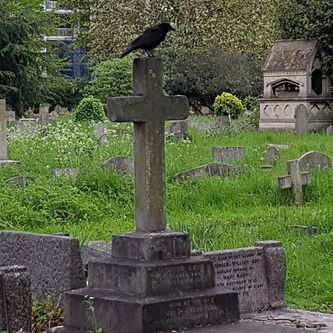 Any time my husband and I travel, we always make an effort to visit a local cemetery. Each one is different. Paul takes photographs, and I wander and visit the graves that I feel pulled to.
Any time my husband and I travel, we always make an effort to visit a local cemetery. Each one is different. Paul takes photographs, and I wander and visit the graves that I feel pulled to.
Many of the cemeteries in the Midwest, where I grew up, are calm, almost drowsy, places, often in the oldest part of town. Huge oak and maple trees give a feeling of comfort and solidarity, and many of the plots are grouped by family name, so you can discern their history even if you don’t know them personally. Some are tiny, and some are wide-open “rural” cemeteries.
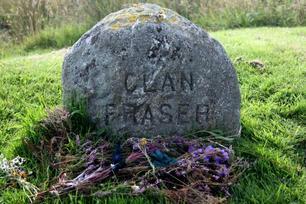 Others, like the stark stone markers at the Culloden Battlefield in Scotland, are filled with gut-wrenching grief.
Others, like the stark stone markers at the Culloden Battlefield in Scotland, are filled with gut-wrenching grief.Tours are given of the monument, and as you walk the wind-swept steps to relive that battle, the wind sings the names of those doomed clansmen. It was haunting.
Before 1831, America had no cemeteries. It’s not that Americans didn’t bury their dead, but that large, modern graveyards did not exist.
With the construction of Mount Auburn Cemetery in Cambridge, Massachusetts, America began to build large cemeteries in its more populated areas.
 Mount Auburn Cemetery, Cambridge, MA Now the dead were not buried in a family plot, or in the middle of town. They were contained and kept away from the realm of the living. Often these cemeteries featured an elaborate entrance gate that marked the fact that the visitor was leaving the mundane world behind. Cemeteries operated as complex, alternate cities—cities of the dead.
Mount Auburn Cemetery, Cambridge, MA Now the dead were not buried in a family plot, or in the middle of town. They were contained and kept away from the realm of the living. Often these cemeteries featured an elaborate entrance gate that marked the fact that the visitor was leaving the mundane world behind. Cemeteries operated as complex, alternate cities—cities of the dead.These new cemeteries, places with winding roads and picturesque vistas, suggested that one leave the mundane world outside the gates and enter into a liminal space where you could meditate, concentrate, and perhaps come into contact with spirituality.
At the time, there weren’t many public parks, or botanical gardens, or art museums in American cities.
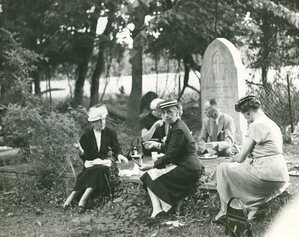 Now, suddenly, here was this large piece of ground, filled with beautiful sculptures and art. The tombstone-laden fields were the closest things to modern-day public parks, and people flocked to them. For picnics, carriage rides, family strolls.
Now, suddenly, here was this large piece of ground, filled with beautiful sculptures and art. The tombstone-laden fields were the closest things to modern-day public parks, and people flocked to them. For picnics, carriage rides, family strolls.In Dayton, Ohio, for instance, Victorian-era women promenaded through Woodland Cemetery, en route to luncheon at their homes. New Yorkers strolled through Saint Paul’s Churchyard in Lower Manhattan, to picnic on fruits, ginger snaps and sandwiches.
One of the reason why picnicking in cemeteries became a “fad,” was that epidemics were raging across the country. Yellow fever and cholera flourished, children passed away before 10, women died in childbirth. Death was a constant visitor for many families. By visiting the cemeteries casually, instead of just for burials, people could visit and break bread with family and friends, both living and deceased, and feel comfort from their presence, rather than grief.
 Spring Grove Cemetery, Cincinnati Ohio Plus, the layout and tone of cemeteries in America changed the way people felt about visiting them.
Spring Grove Cemetery, Cincinnati Ohio Plus, the layout and tone of cemeteries in America changed the way people felt about visiting them.Whereas both American and European graveyards had long been austere places on Church grounds, full of memento mori and reminders not to sin, the new cemeteries were located outside of city centers and designed to look like gardens.
“Grave markers in the 19th century cemeteries featured angels, weeping willows, little sleeping children sitting on top of headstones,” says Keith Eggener, in his book, Cemeteries. “These all suggest that death is a kind of gentle sleep. Graves are set up as beds or houses. The last house.”
Flower motifs replaced skull and crossbones, and the public was welcomed to enjoy the grounds.
Some graveyards were so beautiful they practically begged for a checkered tablecloth and a nice bottle of Chenin Blanc.
 Strolling Woodland Cemetery, Dayton, Ohio In some parts of the country, the influx of grave picnickers grew so large that police intervention was needed. The cemeteries were becoming littered with garbage. In one report, the author wrote, “thousands strew the ground with sardine cans, beer bottles and lunch boxes.”
Strolling Woodland Cemetery, Dayton, Ohio In some parts of the country, the influx of grave picnickers grew so large that police intervention was needed. The cemeteries were becoming littered with garbage. In one report, the author wrote, “thousands strew the ground with sardine cans, beer bottles and lunch boxes.”
Cemetery picnics remained popular until the 1920s. By then, medical advances made early deaths less common, and public parks sprouted up across the nation, replacing cemeteries as places for public walks.
 And once again, the cemetery design changed. Gone were the winding paths and massive stone grave headstones and cradles. These modern sites, called “memorial parks,” put a lot less emphasis on death than the older cemeteries. Their imagery are stark, with mostly flat stones engraved with name and date, and maybe a cross or a small flower. Instead of a lot of individual stones, only an occasional marker rises up to break the flat landscape. The emphasis is not on death, but on hopefulness.
And once again, the cemetery design changed. Gone were the winding paths and massive stone grave headstones and cradles. These modern sites, called “memorial parks,” put a lot less emphasis on death than the older cemeteries. Their imagery are stark, with mostly flat stones engraved with name and date, and maybe a cross or a small flower. Instead of a lot of individual stones, only an occasional marker rises up to break the flat landscape. The emphasis is not on death, but on hopefulness.“People don’t go out to the memorial park very often,” says Eggener. “They’re an American phenomenon. We send our old people off to homes and hospitals to die. We only go to the cemetery for funerals and after that we avoid them.”
In the last few years, the funeral industry has reincarnated itself yet again. Many people today disagree with the traditional funeral as the only proper way to deal with a death. You know the kind of funeral service they mean: Purchase an expensive casket, buy a grave plot, and have several large vehicles taxi the relatives to and from the cemetery.
Green burial is becoming popular for the environmentally concerned. It’s a return to first practices, if you will.
 Instead of putting an embalmed body into a metal coffin set into a hermetically sealed concrete vault, the body is left unembalmed. It may be wrapped in a shroud and put into a simple box made of a natural material, such as untreated pine, bamboo, wicker or seagrass. Some people opt for Farm-raised, sustainable wood such as cherry or mahogany. Often they are constructed with retractable or removable handles so that there is no metal remaining upon burial.
Instead of putting an embalmed body into a metal coffin set into a hermetically sealed concrete vault, the body is left unembalmed. It may be wrapped in a shroud and put into a simple box made of a natural material, such as untreated pine, bamboo, wicker or seagrass. Some people opt for Farm-raised, sustainable wood such as cherry or mahogany. Often they are constructed with retractable or removable handles so that there is no metal remaining upon burial.Family and friends can decorate the coffin with personal messages using environmentally friendly pens or paints, and place flowers on the top.
 The caskets are placed directly into the earth instead of using concrete crypts and vaults. The whole idea with a green burial is that the body and container can decompose in a natural manner. In years to come all that should remain at the burial site is the skeleton of the deceased gently encased in the earth.
The caskets are placed directly into the earth instead of using concrete crypts and vaults. The whole idea with a green burial is that the body and container can decompose in a natural manner. In years to come all that should remain at the burial site is the skeleton of the deceased gently encased in the earth.In the United States there are now 41 sites in 26 states. Most natural burial sites are un-landscaped woodland and meadow areas where bodies are inconspicuously buried among natural vegetation.
Some form of natural stone markers or GPS coordinates may be used to designate and mark out the gravesite. Some green burial sites plant trees as opposed to using grave markers and headstones making the whole process an even more natural form of burial.
No matter the path chosen, green funerals cost less money and are friendlier to the environment. A traditional burial service including an upper-end casket with all the trimmings can top $10,000. In comparison, a green funeral can cost under $2000.
Opting to be cremated is also on the increase, and this again reflects these changing cultural trends in the death industry. Many families are choosing a simple cremation, and then scattering the ashes, as a more organic return to nature.
 Personally, I like the idea of being connected back to the earth—becoming food for somebody or something, and also being connected to a place, if just for a generation or two.
Personally, I like the idea of being connected back to the earth—becoming food for somebody or something, and also being connected to a place, if just for a generation or two.It’s vain to think that people will come back and visit for generations, but I’d like to have a place where my children and their children could spend some time with me. After that, I’m fine with being re-released to Mother Gaia. I’ll leave you with a few pointers on cemetery etiquette, for the time you plan a family picnic in your local cemetery:
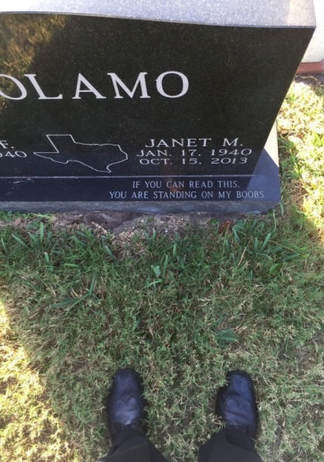 Always try to walk between, not on top of, the grave.If it’s a family grave, check on the condition of your loved one’s granite headstone. It takes thousands of years for a quality granite monument to show any signs of deterioration. However, it can quickly become soiled or stained, gather moss or mildew, collect animal droppings or leaves and twigs. Cemeteries cut the grass and trim the area around the gravestone and plot, but it is up to you to keep the monument looking beautiful. Come prepared to the clean the monument and beautify the plot. Whisk off the dirt, sticks, and grass. Bring some soap and water and a rag and clean the monument.
Always try to walk between, not on top of, the grave.If it’s a family grave, check on the condition of your loved one’s granite headstone. It takes thousands of years for a quality granite monument to show any signs of deterioration. However, it can quickly become soiled or stained, gather moss or mildew, collect animal droppings or leaves and twigs. Cemeteries cut the grass and trim the area around the gravestone and plot, but it is up to you to keep the monument looking beautiful. Come prepared to the clean the monument and beautify the plot. Whisk off the dirt, sticks, and grass. Bring some soap and water and a rag and clean the monument. 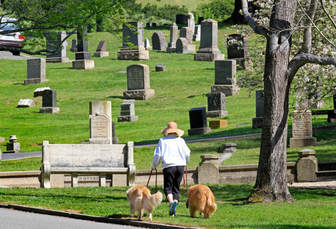 Many people take their pets to visit loved ones, while others enjoy the solemn walk through a cemetery.
Many people take their pets to visit loved ones, while others enjoy the solemn walk through a cemetery.If you do, leash your pets. Before you bring your pet along, check to make sure it’s not against the rules, and keep them on a leash at all times. More importantly, bring your pooper-scooper or whatever method you prefer to clean up after your pet. Know the rules before you go. Most cemeteries have a sign posted near the entrance listing rules specific to the property. That sign does you no good if you’re there at 5:00pm with a shepherd’s hook and hanging plant in tow and a large sign tells you visiting hours ended at 4:00pm and a shepherd’s hook is listed in bold print with a variety of other prohibited items. Most cemeteries have websites where their rules are listed along with visiting hours. Some of the more advanced sites let you search your loved one and will provide their location information with a map of the cemetery. If your family cemetery does not offer much information on their website or if they do not have one at all, call the cemetery and ask about visiting rules and regulations. The information desks can also provide you with location information.
Never remove anything from a gravestone even if it’s an arrangement of flowers that has dried up and wilted weeks before you even got there.
If you’d like, follow the custom of leaving a penny at a military grave, or a smidge of tobacco discretely at any stranger’s grave you visit.
Unless you are a direct descendant of the grave holder in question, the practice of charcoal transfers is a “don’t.” Even worse is the use of shaving cream on old headstones to make them more legible. It breaks down the headstone materials
Photographing graveyards is okay. Photographing mourners in the act of mourning is not.
An impromptu altar or small offering is acceptable—provided the grave is not visited regularly by family members. On an abandoned grave, the gesture is touching and sweetly pagan, when done in good taste.
Appropriate offerings at more well-known graves is also allowed. The mysterious bottle of cognac and trinity of roses left on Edgar Allan Poe’s grave in Baltimore? A little dramatic maybe, but appropriate nonetheless. Guitar picks and whiskey, at Jim Morrison’s headstone? Absolutely fitting.
Just as an FYI for the necromantic namaste crowd, Greenwood Cemetery in Brooklyn, NY, offers weekend yoga classes among the gravestones. Seriously. I'm going to be diligently churning out novel words for NaNoWriMo (National Novel Writing Month) all this month, so my November posts will all reflect that theme.
Until next week--Good reading!
Published on November 02, 2018 18:13
October 27, 2018
Dia de los Muertos
 Although it may be celebrated at roughly the same time, Dia de los Muertos, or Day of the Dead, is not a Mexican version of Halloween.
Although it may be celebrated at roughly the same time, Dia de los Muertos, or Day of the Dead, is not a Mexican version of Halloween.The two annual events originated in different parts of the world, and they differ greatly in tone.
Halloween, or All Hallows Eve, has its roots in the ancient, pre-Christian Celtic festival of Samhain, which was celebrated on the night of October 31. The Celts, who lived 2,000 years ago in the area that is now Ireland, the United Kingdom and northern France, believed that the dead returned to earth on Samhain. They burned bonfires and wore masks to ward off ghosts.
The theme of Dia de los Muertos is also death, but the point is to demonstrate love and respect for deceased family members. In towns and cities throughout Mexico, Central America, and parts of the United States, revelers paint their faces like skeletons, wear costumes, hold festivals and parades, and make offerings to lost loved ones.
At its core, the holiday is a reaffirmation of indigenous life. Dia de los Muertos originated several thousand years ago with the Aztec, Toltec, and other Nahua people, who considered mourning the dead disrespectful. For those pre-Hispanic cultures, death was a natural phase in the circle of life. The dead were still members of the community, kept alive in memory and spirit—and during Dias de los Muertos, they temporarily returned to Earth.
 Today’s celebration combines indigenous Aztec ritual with Catholicism, brought to the region by the Spanish conquistadores.
Today’s celebration combines indigenous Aztec ritual with Catholicism, brought to the region by the Spanish conquistadores.The holiday is actually spread over two days, November 1 and 2. November 1 is Dia de los Inocentes, honoring children who have died. Graves are decorated with white orchids and baby’s breath. November 2 is Dia del los Muertos, honoring adults, whose graves are decorated with bright orange marigolds.
 The centerpiece of the celebration is a temporary altar, or ofrenda, built in private homes and cemeteries. They altars aren’t for worship, they’re meant to welcome spirits back to the realm of the living, and provide them with what they need on their journey. That’s why you may see some unusual items, such as a washbowl and razor, or a pillow and blanket at the grave, in addition to photos and mementos.
The centerpiece of the celebration is a temporary altar, or ofrenda, built in private homes and cemeteries. They altars aren’t for worship, they’re meant to welcome spirits back to the realm of the living, and provide them with what they need on their journey. That’s why you may see some unusual items, such as a washbowl and razor, or a pillow and blanket at the grave, in addition to photos and mementos.Marigolds are scattered from altar to gravesite. With their strong scent and vibrant color, the petals make a path that leads the spirits from the cemetery to their families’ homes.
 You’ll often see images of Monarch butterflies at the site, because they are believed to hold the spirits of the departed. This belief stems from the fact that the first monarch arrive in Mexico, their winter migration destination, on November 1.
You’ll often see images of Monarch butterflies at the site, because they are believed to hold the spirits of the departed. This belief stems from the fact that the first monarch arrive in Mexico, their winter migration destination, on November 1.  Often a statue of Xoloitzcuintli, a dog, are left to help guide the spirits back to heaven when the party’s over. Other offerings include pan de muerto (bread of the dead) and the deceased’s favorite foods, as well as toys for children, and alcohol.
Often a statue of Xoloitzcuintli, a dog, are left to help guide the spirits back to heaven when the party’s over. Other offerings include pan de muerto (bread of the dead) and the deceased’s favorite foods, as well as toys for children, and alcohol.Every ofrenda also include the four elements: water, wind, earth and fire. Water is left in a pitcher so the spirits can quench their thirst.
 Papel picado, or traditional paper banners, represent the wind. Earth is represented by food.
Papel picado, or traditional paper banners, represent the wind. Earth is represented by food.And candles are burned for fire. The smoke from copal incense, made from tree resin, transmits praise and prayers and purifies the area around the altar. The most familiar symbol of Dias de los Muertos may be the calacas and calaveras (skeletons and skulls), which appear everywhere during the holiday: in candied sweets, as parade masks, as dolls.
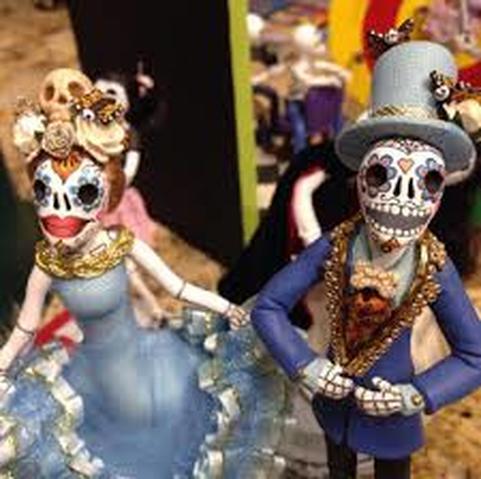 Although their flesh may have disappeared their cultural associations have not. Skeletons representing firefighters may still ride in a fire truck, for instance, or a calaca of a vaquero (cowboy) may still ride a horse.
Although their flesh may have disappeared their cultural associations have not. Skeletons representing firefighters may still ride in a fire truck, for instance, or a calaca of a vaquero (cowboy) may still ride a horse.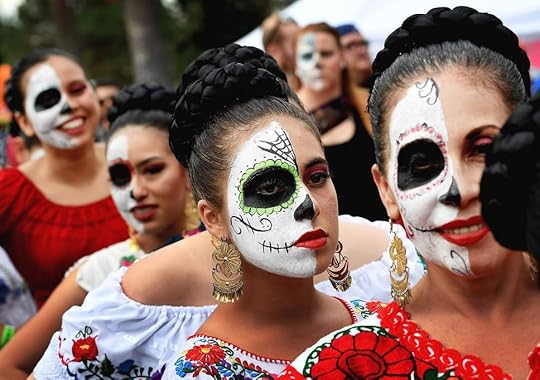 Often masks and other skeleton and skull decorations are only half-decorated. The artwork reminds us that every human being, no matter how beautiful or well-dressed, will eventually be exposed as nothing more than a skeleton and skull. The half-decorated calacas and calaveras recognize this duality.
Often masks and other skeleton and skull decorations are only half-decorated. The artwork reminds us that every human being, no matter how beautiful or well-dressed, will eventually be exposed as nothing more than a skeleton and skull. The half-decorated calacas and calaveras recognize this duality. 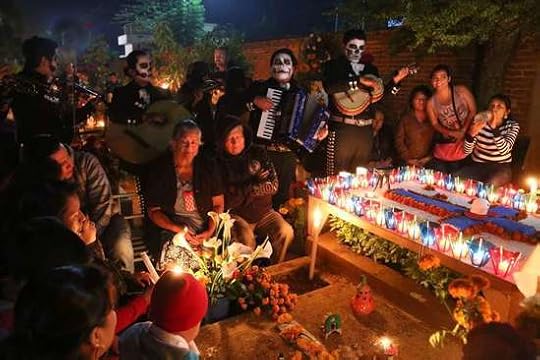 During Day of the Dead celebrations, it’s not uncommon for friends and relatives to visit graveyards and spend the night. They’ll clean the graves, make offerings and have candlelight vigils.
During Day of the Dead celebrations, it’s not uncommon for friends and relatives to visit graveyards and spend the night. They’ll clean the graves, make offerings and have candlelight vigils. Then the party begins, with food, music and storytelling. Nobody tells ghost stories though. Most of the tales are humorous remembrances of loved ones.
If this tradition seems rather macabre, you may be surprised by nt week's post. Turns out, graveside lounging used to be all the fashion in the United States. I’ll tell you why Americans picnicked in cemeteries next week.
Until then…Happy Samhain!
And a festive Dia de los Muertos!
Published on October 27, 2018 17:55
October 19, 2018
NaNoWriMo Story Starters
 I skipped a blogging week to attend my son Josh’s wedding in Wisconsin last weekend.
I skipped a blogging week to attend my son Josh’s wedding in Wisconsin last weekend.
And now… it’s almost time for that month of madness known as NaNoWriMo (National Novel Writing Month).
Do you know what the plot of your novel will be? The personalities of each of the main characters? The escalating crisis that will build to your climactic final scene?
Or are you starting from scratch, without a plot or any idea of characters?
If you’re struggling, here are some ideas to help get you started. Feel free to plagiarize anything here. Please add suggestions in the comments section below. I’d love to have some fresh ideas too.
A woman buys an antique bureau. In the backboard, she finds a mysterious map with a route marked in symbols. When he was picked to be Mr. February for the Firemen’s calendar, he thought his romance worries were over. The holidays with relatives were always strained, but the couple expected even more discord this year, considering what had happened. A woman is killed while walking her dog. Her spirit enters the dog’s body and decides to cohabitate alongside the dog’s spirit. The old man sat on the park bench soaking up the warm summer sun when a familiar face walked by that sent a chill up his spine It's a freezing cold night. Your character finds a homeless family on your doorstep and invites them into his home to sleep. But in the morning, the family won't leave.
After an automobile accident, a woman begins to see auras around people’s heads that indicate their good and evil thoughts.
A huge crowd of the undead stood pounding on the doors of St. Peter’s Cathedral seeking salvation. It wasn’t until they were in bed together that she noticed the green reptilian skin on his back. What if a lethal virus spread across the world, and vampires were enlisted to help prolong the life of those few people who produced antibodies? Children playing in the woods find something odd sticking out of the ground and start digging. A woman inherits her Scottish uncle’s castle and possessions, but she must destroy the contents of the attic without examination. Write a spin-off article about an interesting historical or scientific topic that is mentioned in your novel. Write short stories that can be spin-offs for your major novel characters. What if global warming caused large scale melting at the major Arctic regions on Earth? What changes will take place in the world? How much of the world would be under water? In what regions would humans be most likely to survive, and how would those regions cope with the tremendous influx of people? What if the bees on Earth died off? Write about the ‘trickle-down’ effect of that loss on crops, food, animals and humans. You are the patient of a psychiatrist who has been murdered, and you think you know who killed him. While planting a tree in the back yard of your new house, you accidentally dig up human bones. You suspect that your next door neighbor is a witch, and you decide to investigate and learn more. You put down your dog’s food, but today he ignores it. Instead, he sits down and begins talking to you, starting with what he’d really like to eat this morning, the errands he wants you to run with him, and the things he needs your help to accomplish. While visiting the art museum, you stop in front of a particular scene, and find you can step into the painting and be transported there. A group of friends band together to survive following a nationwide terrorist attack on the country’s energy infrastructure. My next door neighbors, The Johnsons, were all asleep in their coffins when I climbed the fence to get the ball. Your character's car breaks down when he is driving home from a business trip late at night. Fortunately, there is a hotel nearby, so the character decides to stay there and deal with the car in the morning. This hotel is creepy. Why? Create the atmosphere. According to the hotel's policy, the character pays in advance for the night. When he goes up to his room, and things get even creepier. How? Show us. Your character wants to leave the place but tells himself he's being irrational. He's already paid for the room, and he tells himself everything will be fine. But it gets worse. Depending on how you write this, it could be a ghost story, a crime story, a realistic psychological drama, or a comedy. You could even try your hand at all of them and write four stories. At a Chinese restaurant, your character opens his fortune cookie and reads the following message: "Your life is in danger. Say nothing to anyone. You must leave the city immediately and never return. Repeat: say nothing." In an emergency, a small boy is left to stay with his grandfather for several days. The grandfather pretends to be annoyed at the inconvenience, but, secretly, he is delighted. He adores the boy. He is embarrassed about displaying emotion, so he acts gruff with the child, who is therefore frightened of him at the beginning of the visit. Show the old man's actions, but also let his real feelings show through. At the airport, a stranger offers your character money to carry a mysterious package onto the plane. The stranger assures your character that it's nothing illegal and points out that it has already been through the security check. Your character has serious doubts, but needs the money, and therefore agrees. At a garage sale, your character buys an antique urn which she thinks will look nice decorating her bookcase. But when she gets home, she realizes there are someone's ashes in it. Your character starts receiving flowers and anonymous gifts. She doesn't know who is sending them. Her husband is suspicious, and the gifts begin to get stranger. Your character meets someone on an online dating site. Your character writes an e-mail to the person, describing him/herself. Write the e-mail. This e-mail contains two lies. What are they? Why did the character tell them? Also: your character has a very mistaken idea of the impression he/she makes on other people. What impression does your character think he/she makes? What impression does he/she really make? Figure all this stuff out. If you want, fill out a character profile. Your character arranges an in-person meeting with the person he/she has met online. What happens at the meeting? Write the story. While housesitting his teenage grandson while the parents are on an extended vacation, Grandpa Reed discovers that his grandson has a small marijuana plantation behind the garage. Grandpa confronts the grandson, who, instead of acting repentant, explains to him exactly how much money he is making from the marijuana and tries to persuade Grandpa to join in the business. Did one of these prompts spark your writing interest? I know I have listed several I’d like to explore. If you would like to list other ideas, drop them in the comments section.
Next week’s blog is on Dia de Los Muertos, traditions for Day of the Dead, which runs from October 31-November 2.
In the meantime, get those NaNo ideas churning!
Published on October 19, 2018 12:12
October 8, 2018
Rules of Magic
The movie Practical Magic had been out a few years by the time I began studying witchcraft. But once I watched the Midnight Margarita scene, with the elder sisters Franny and Jet dancing around the kitchen making margaritas and singing, “Put the lime in the coconut and mix it all up,” I was hooked. THIS was the witchy life I wanted! I loved the aunt’s comfort in their own skins and with each other, their confidence with magic, and their power. I wanted to be them.
I immediately went back and read the book, and was glad I’d done things in that order. The movie gave me a house and garden—and kitchen dance—to love. The book gave me a more in-depth look at Sally (Sandra Bullock) and Gillian (Nichole Kidman) Owens, and the misfortune that follows them made more sense. But still…what about the aunts?
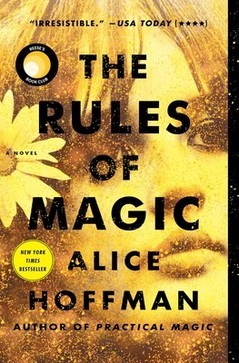 In her latest book, The Rules of Magic, Author Alice Hoffman has finally returned to the Owens family to fill out the family backstory on the mysterious “aunts” Francis (called Franny), and Bridget (known as Jet). And—surprise! They had a baby brother!
In her latest book, The Rules of Magic, Author Alice Hoffman has finally returned to the Owens family to fill out the family backstory on the mysterious “aunts” Francis (called Franny), and Bridget (known as Jet). And—surprise! They had a baby brother!
The Owens women have always had grey eyes, an intrinsic understanding of hedge witch spellwork, and bad luck in love. Like all the other Owens women, Frances and Jet are witches descended from Salem escapee Maria Owens. More than 300 years ago, Maria was seduced and abandoned by Salem trial judge John Hathorne (real-life ancestor of Nathaniel Hawthorne, who added a “w” in his name to avoid comparison).
The fact that Maria’s lover was a state-sponsored serial killer of women led the young witch to conclude that all men are bad. Maria decided to protect her female descendants by casting a spell to ensure that every male who loves an Owens woman will die, horribly.
The only Owens male in centuries was the third child of Susanna, an Owens who fled Massachusetts as soon as she could, desperate to remove herself from the stigma clinging to her family name. This is where The Rules of Magic story begins.
In New York City during the 1960s, Susanna Owens knows that her three children are dangerously unique.
To protect them, Mom has a myriad of rules: “No walking in the moonlight, no Ouija boards, no candles, no red shoes, no wearing black, no going shoeless, no night-blooming flowers, no amulets, and no reading books about magic, no cats, and no crows. And no venturing below 14th Street.”
Franny, the oldest, pale as porcelain, with “blood-red” curly hair and “an ability to commune with birds,” tries to abide by those rules. So does the shy beauty, Jet, whose knack to reading people’s thoughts helps her stay out of trouble.
But little brother Vincent, as charismatic as a newborn that a hospital nurse tried to steal him for herself, has his own ideas. He’s barely a teenager before he’s climbing out his bedroom window, to sneak below 14th street and strum his guitar on street corners in Greenwich Village.
When Franny turns 17, in accordance with generations of family tradition, she is summoned to spend the summer at the family manor with the current matriarch, Aunt Isabelle, and she gets permission to bring her siblings with her.
Aunt Isabelle is completely different from their mother. She allows the children to hone their magical skills, shows them how to make black soap and which herbs will cause a married man to leave his wife.
More dramatically, their rebellious cousin April, confirms the family curse. Any man who loves an Owens is doomed. Then they find Maria’s journal, in which she urges her descendants to “fall in love whenever you can.” Talk about your summer of transformation. What teenager can resist falling in love—but even if it means your lover dies?
The contradiction between curse and command is at the heart of Franny, Jet, and Vincent’s lives.
In the summer that they go to stay at Aunt Isabelle, at least four local boys suffer shocking deaths.
Aunt Isabelle is calmly fatalistic about the whole thing, and encourages the girls to keep loving boys anyway, saying,
“When you truly love someone and they love in return you ruin your lives together. That is not a curse. It’s what life is, my girl.”
The Rules of Magic is the perfect read for Halloween. There’s magic, yes. But it’s set against the historical backdrop of real events like the Vietnam War, draft evasion and San Francisco’s Summer of Love. The whole novel is a commingling of dreamy, lyrical fairy tale and real-life struggles.
The end of the story was satisfying, and I was pleased that it led all the way up to the start of Practical Magic, so we can see how Sally and Gillian’s story begins.
Most importantly for me, the characters started flawed, and, despite their growth, they still weren’t perfect. I loved Franny, Jet and Vincent for all the more for those chinks in their power.
Next week I'll be posting NaNoWriMo story starter tips to get ready for November. Then I'll drop back to October and talk about Dia de Los Muertos, and customs for honoring ancestors in Mexico and the Southwest.
See you next week. Get those Halloween/Samhain decorations up! IF you'd like to post photos, I'd love to see them.
I immediately went back and read the book, and was glad I’d done things in that order. The movie gave me a house and garden—and kitchen dance—to love. The book gave me a more in-depth look at Sally (Sandra Bullock) and Gillian (Nichole Kidman) Owens, and the misfortune that follows them made more sense. But still…what about the aunts?
 In her latest book, The Rules of Magic, Author Alice Hoffman has finally returned to the Owens family to fill out the family backstory on the mysterious “aunts” Francis (called Franny), and Bridget (known as Jet). And—surprise! They had a baby brother!
In her latest book, The Rules of Magic, Author Alice Hoffman has finally returned to the Owens family to fill out the family backstory on the mysterious “aunts” Francis (called Franny), and Bridget (known as Jet). And—surprise! They had a baby brother!The Owens women have always had grey eyes, an intrinsic understanding of hedge witch spellwork, and bad luck in love. Like all the other Owens women, Frances and Jet are witches descended from Salem escapee Maria Owens. More than 300 years ago, Maria was seduced and abandoned by Salem trial judge John Hathorne (real-life ancestor of Nathaniel Hawthorne, who added a “w” in his name to avoid comparison).
The fact that Maria’s lover was a state-sponsored serial killer of women led the young witch to conclude that all men are bad. Maria decided to protect her female descendants by casting a spell to ensure that every male who loves an Owens woman will die, horribly.
The only Owens male in centuries was the third child of Susanna, an Owens who fled Massachusetts as soon as she could, desperate to remove herself from the stigma clinging to her family name. This is where The Rules of Magic story begins.
In New York City during the 1960s, Susanna Owens knows that her three children are dangerously unique.
To protect them, Mom has a myriad of rules: “No walking in the moonlight, no Ouija boards, no candles, no red shoes, no wearing black, no going shoeless, no night-blooming flowers, no amulets, and no reading books about magic, no cats, and no crows. And no venturing below 14th Street.”
Franny, the oldest, pale as porcelain, with “blood-red” curly hair and “an ability to commune with birds,” tries to abide by those rules. So does the shy beauty, Jet, whose knack to reading people’s thoughts helps her stay out of trouble.
But little brother Vincent, as charismatic as a newborn that a hospital nurse tried to steal him for herself, has his own ideas. He’s barely a teenager before he’s climbing out his bedroom window, to sneak below 14th street and strum his guitar on street corners in Greenwich Village.
When Franny turns 17, in accordance with generations of family tradition, she is summoned to spend the summer at the family manor with the current matriarch, Aunt Isabelle, and she gets permission to bring her siblings with her.
Aunt Isabelle is completely different from their mother. She allows the children to hone their magical skills, shows them how to make black soap and which herbs will cause a married man to leave his wife.
More dramatically, their rebellious cousin April, confirms the family curse. Any man who loves an Owens is doomed. Then they find Maria’s journal, in which she urges her descendants to “fall in love whenever you can.” Talk about your summer of transformation. What teenager can resist falling in love—but even if it means your lover dies?
The contradiction between curse and command is at the heart of Franny, Jet, and Vincent’s lives.
In the summer that they go to stay at Aunt Isabelle, at least four local boys suffer shocking deaths.
Aunt Isabelle is calmly fatalistic about the whole thing, and encourages the girls to keep loving boys anyway, saying,
“When you truly love someone and they love in return you ruin your lives together. That is not a curse. It’s what life is, my girl.”
The Rules of Magic is the perfect read for Halloween. There’s magic, yes. But it’s set against the historical backdrop of real events like the Vietnam War, draft evasion and San Francisco’s Summer of Love. The whole novel is a commingling of dreamy, lyrical fairy tale and real-life struggles.
The end of the story was satisfying, and I was pleased that it led all the way up to the start of Practical Magic, so we can see how Sally and Gillian’s story begins.
Most importantly for me, the characters started flawed, and, despite their growth, they still weren’t perfect. I loved Franny, Jet and Vincent for all the more for those chinks in their power.
Next week I'll be posting NaNoWriMo story starter tips to get ready for November. Then I'll drop back to October and talk about Dia de Los Muertos, and customs for honoring ancestors in Mexico and the Southwest.
See you next week. Get those Halloween/Samhain decorations up! IF you'd like to post photos, I'd love to see them.
Published on October 08, 2018 11:24
October 3, 2018
Wendy Rule New Release this Month
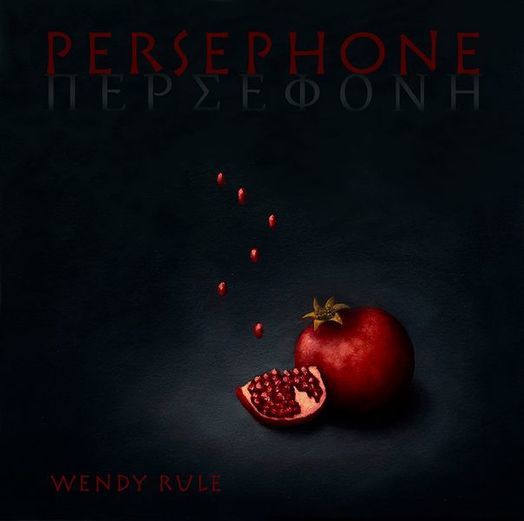 I had the pleasure of hanging out with my friend, performer Wendy Rule, last weekend while she was performing in Arizona. I attended two of her concerts, and hosted her afterwards for one night at our cabin.
I had the pleasure of hanging out with my friend, performer Wendy Rule, last weekend while she was performing in Arizona. I attended two of her concerts, and hosted her afterwards for one night at our cabin.We started Friday night in downtown Phoenix at The Listening Room. This is a unique venue because host Adam Smith holds a “song swap.” Before singing her regular set, Wendy performed a beautiful song of Adam’s, Sea of Dreams. In exchange, Adam performed one of Wendy’s songs. That was followed by an informal conversation about performing, how they come up with song ideas, and life in general, with Wendy answering questions from the audience.
I response to an audience question about witchcraft, Wendy said she discovered the Craft in her mid-twenties, while she was pregnant with her son, Rueben.
“After his birth, I got this epiphany, an epic flow of magic, and a really strong connection with the Goddess.” Rule’s new found path in witchcraft naturally bled into her music. Immediately, in fact. “All of these songs just came pouring out of me,” she said. “I wrote my first album in a matter of months. I decided to write a song for every card of the Tarot major arcana.” Hence the name of that album, Zero.
“I didn’t know how to play guitar when I started,” she admitted, “so I composed the songs and then taught myself chords and just progressed from there.”
Since the debut of Zero in 1996, Wendy has moved from her native Australia to the United States, settling first in Oregon, and now in Santa Fe, New Mexico. And, yes, she has become a very proficient guitarist.
She has released nine other studio albums, including my two personal favorites, Wolf Sky in 2006, and Black Snake in 2013. In the latter album, she is backed by son Reuben George Bloxham on bass, organ and ambient electric guitar, husband Tim on Native American flute and electric guitar, and guest musicians on cello, violin and marimba.
The Black Snake album is probably Rule’s darkest, and she shared with us that she was going through a stretch of deep depression when she began writing those songs. Because of that, she says, “Black Snake celebrates the universal themes of death and rebirth, of descent and re-awakening.”
The next night we moved to Sedona, AZ for her performance at the intimate and welcoming Synergy Lounge. Wendy told us more about her 12-year labor of love to produce her upcoming album, Persephone, which will be released on October 31 (her birthday).
“Persephone is unlike anything I’ve written before," she says. A double album with 24 tracks of songs and chant, it’s an opera-like telling of the Greek myth: Goddess Persephone’s abduction by the God Hades, her descent into the Underworld to become his bride, and her mother Demeter’s attempts to find her beloved daughter and bring her back to Earth above.
 Wendy Rule as Hecate in her new release Persephone.
Wendy Rule as Hecate in her new release Persephone. Photo by Karen Kuehn dy sings the roles of the three Goddess aspects featured in the myth, Persephone (Maiden), Demeter (Mother), and Hecate (Crone), whose parts she chants and sings in Greek.
To research and prepare for Persephone, Wendy made several trips to Greece, visiting the sacred sites dedicated to Persephone and Demeter, as well as learning the language.
The arrangements she played for us are beautiful and otherworldly, and I’m sure when all collaborators are included, the songs will be amazing. Artists will include Elissa Goodrich on vibraphone, marimba and percussion; Rachel Samuel on cello; and dark Underworld soundscapes by Wendy’s husband, Timothy Van Diest.
A “Greek Chorus” is sung in harmony by five women with diverse voices ranging from rock to opera, and coming from equally diverse locations—Greece, Australia, Portugal and New Mexico.
And renowned Australian performer Mikel Simik (aka Mikelangelo) makes a guest appearance as the voice of Hades.
Fiercely independent, Wendy Rule has always carved a unique path through the musical mainstream. She’s been popular for years in the pagan and magical community, but I think Persephone will gain her a broader following. She already has some unusual performances booked within the Sydney arts community.
If you’d like to pre-order Persephone, check out her website, www.wendyrule.com, and click on Persephone in red at the top of the page. You’ll also have the opportunity to order release-related promo items, including a printed booklet that gives details of the Greek Persephone myth, jewelry, a tee shirt, and personally-made items such as tarot bags and tarot cloth.
Oh, and if you’d like to commune with Wendy on a monthly basis, this busy lady also live-streams full moon concerts every month, weaving music, meditation, magic and affirmations into her on-line musical sacred circle. You’ll find information on upcoming and past full moon concerts on her website as well.
Magic and music. A perfect combination. Blessed Be!
Published on October 03, 2018 12:06
September 20, 2018
Celebrate Mabon
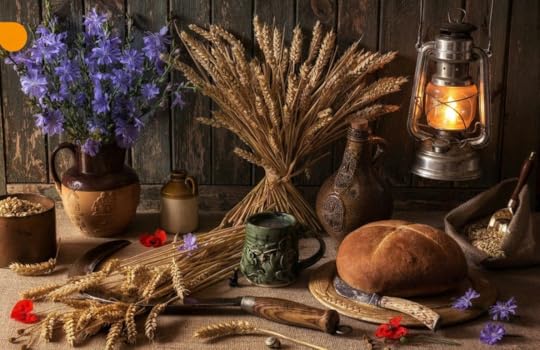 Autumn.
Autumn.Two sounds are unmistakable.
The hurrying rustle of crisp leaves blown along the street by a gust of wind. And the honking of a flock of migrating geese overhead. Both of these are harbingers of chill days ahead.
The Fall Equinox, also known as Mabon, or Harvest Home, fall on or around September 21, and draws an end to the harvest season. It’s the time to honor the changing seasons, and give thanks for what we have, whether it is abundant crops or other blessings.
At the Fall Equinox, the sun enters the astronomical sign of Libra. Libra’s sign is the scales, depicting a state of perfect balance.
 The earth is in perfect balance as well. Day and night, light and dark are in a state of equilibrium at the start of autumn.
The earth is in perfect balance as well. Day and night, light and dark are in a state of equilibrium at the start of autumn.That can affect people in different ways. For some, it’s a season to honor the darker aspects of the goddess, calling upon that which is devoid of light. For others, it’s a time of high energy. There may be a feeling of restlessness in the air, a sense that something is just a bit “off”.
If you’re feeling a bit spiritually lopsided, activities that keep you close to the land, or those that help others, can bring you balance and harmony.
Here are some ways you and your family can gear your fall festivities toward traditional, or more earth-based celebrations:
 Image by Maria Sapotnitska
Image by Maria SapotnitskaPlace some fruits, such as squash and apples in a wooden bowl on your altar. You’ll want to add a pomegranate, in honor of Persephone.
The full Moon closest to the Autumn Equinox (September 24 this year) is the traditional time of the ancient Greek Eleusian Mysteries, in with Persephone was abducted by Hades, lord of the Underworld, to reign as his queen for the next six months, until her return to the surface at the Spring Equinox.
 A cornucopia (horn of plenty) is the perfect item to serve as a centerpiece on your family dining table for these months. Decorate your home or a rented space like an old barn and host a barn dance!
A cornucopia (horn of plenty) is the perfect item to serve as a centerpiece on your family dining table for these months. Decorate your home or a rented space like an old barn and host a barn dance!  A European custom that grew out of the pagan celebrations of the completion of the harvest, this tradition continued in the Colonies.
A European custom that grew out of the pagan celebrations of the completion of the harvest, this tradition continued in the Colonies. If you like wine, you can host a wine-tasting party in honor of the year’s grape harvest Serve wines the traditional way, with bland crackers, yeast breads, and cheese. You can even have a company host in your home, in exchange for a minimum guest purchase. (With my friends, I have never had a problem making the modest minimum.)
If you like wine, you can host a wine-tasting party in honor of the year’s grape harvest Serve wines the traditional way, with bland crackers, yeast breads, and cheese. You can even have a company host in your home, in exchange for a minimum guest purchase. (With my friends, I have never had a problem making the modest minimum.)  Quilting Bees were also fall events. With the cold nights of winter on the way, people crafted new blankets and quilts to keep their family warm. Of course, this activity is much more fun as a group! Many of the quilt patterns hold pagan symbolism, and may have, in fact, grown out of long-forgotten pagan signs of protection.
Quilting Bees were also fall events. With the cold nights of winter on the way, people crafted new blankets and quilts to keep their family warm. Of course, this activity is much more fun as a group! Many of the quilt patterns hold pagan symbolism, and may have, in fact, grown out of long-forgotten pagan signs of protection. Many pagans and Wiccans count Mabon as their Thanksgiving, the perfect time to give to those less fortunate than ourselves. Consider holding a canned food drive. Invite your friends over for a feast, but ask each of them to bring a canned food, dry goods, or baby supplies. Donate the collected bounty to a local food bank or homeless shelter.
Give your energy and time. For one hour this month, put your full energies into a task that doesn’t benefit you personally. Perhaps you can help prepare food for strangers at a food bank. Perhaps you can complete someone else’s dreaded tasks. Maybe you read to children in foster care, or donate your time to AIDS awareness. As you prepare to engage in the activity, and while carrying it out, note any resistance or internal commentary. Note again how you feel at the end of the activity. Do you notice any change?
Natural giving. Choose an hour when you will listen deeply to someone else without commenting about your own life or interests. Simply listen with full attention to the details of the speaker’s words. Repeat back in your own words the information you have heard to demonstrate to the speaker that you have heard what he or she had to say.
 Pick some apples. Apples are the perfect symbol of the Mabon season. Long connected to wisdom and magic, there are many wonderful things you can do with an apple. As you pick the apples, give thanks to Pomona, goddess of fruit trees.
Pick some apples. Apples are the perfect symbol of the Mabon season. Long connected to wisdom and magic, there are many wonderful things you can do with an apple. As you pick the apples, give thanks to Pomona, goddess of fruit trees.Honor the darkness. Without darkness, there is no light. Without night, there can be no day. Despite a basic human inclination to overlook the dark and sleep through it, there are many positive aspects to embracing the dark side of life, if it’s just for a short time. After all, it was Demeter’s love for her daughter Persephone that led her to wander the world, mourning for six months at a time, and bringing us the death of the soil each fall.
Honor someone older than you. In some paths, Mabon is the time of year that celebrates the Crone aspect of the goddess. We often tend to ignore the elderly people in our population. This month, spend time with an older acquaintance, and acknowledge the ways they’ve succeeded in aging gracefully.
 It's time for Second Harvest
It's time for Second HarvestOf colors red and gold.
A time to gather and reap
The fruit from the seeds we sowed.
We honor the spirit of all living things.
We give them our blessings for gifts we've received.
Bless the trees felled for shelter,
Bless the food which once breathed.
Remind us, Oh Spirit, lest we forget,
To take no life lightly,
We all have a debt.
In this eternal circling of life into death.
Each beginning has an ending.
Then it circles full round.
The Oak King dies,
Thus the Holly King is crowned.
Light and dark balanced on an ear of wheat.
As the last grain signals the harvest complete.
Spirit, bring your perfect love to our rite,
That we may always keep balance firmly in sight.
Happy Mabon.
Published on September 20, 2018 20:49
September 15, 2018
Probing Into My Character's Wounds
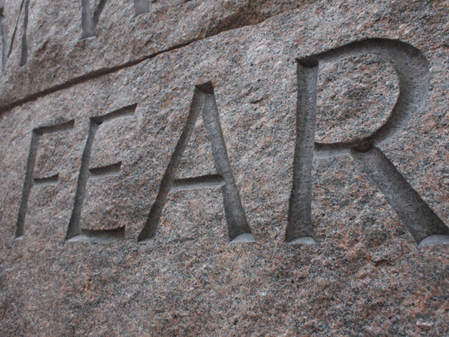 Just like the rest of us, novel characters have wounds in their past, hidden scars they carry with them wherever they go.
Just like the rest of us, novel characters have wounds in their past, hidden scars they carry with them wherever they go.Our pasts are filled with experiences, both good and bad, which taught us who to trust, what to believe in, and what to avoid. The painful experiences—the wounds—influence us so deeply that we will do almost anything to avoid feeling such pain again. That past trauma is likely to affect our future behavior as well.
A writers, how do we create characters who feel realistic? By mirroring real life as much as possible. That means developing a backstory for each character that lets us understand him/her on the deepest level. Knowing who and what influences a character gives us insight to what they fear, desire and need most of all. Sometimes even if the character doesn’t know himself.
Emotional wounds are more than just painful memories. Inside each wound is a seed of doubt. Was it my fault? Could I have stopped it? Was there something else I could have done? It’s human nature to second-guess decisions that result in a bad outcome, to rationalize tragedies, and to make sense of them. Many times we blame ourselves for what happened, even when events were out of our control.
Because of this internalization, a lie is born.
When a person is wounded, he wraps himself in emotional armor to keep his feelings safe. Flaws develop, working under the rationalization of protecting himself from getting hurt. Oftentimes, instead of keeping the person safe, these flaws limit him, preventing him from building healthy relationships, or putting a filter of distrust on all he sees.
For the last several months, I’ve had my novel characters, especially my antagonist, under the microscope, refining his “wounds,” focusing all his hurt and pain into a single backstory moment that explains his motivation (and rationalization) to kill. Now I’ll be able to make this killer relatable and tragic, and I think he will also have a redeemable moment at the end of the book.
Interestingly, while delving deeper into my bad guy, I’ve also been able to bring the backstory wounds of other characters into sharper focus.
Sheriff Cooper Jones was easy for me to figure out from the beginning. He was working late (in his last job), and while he was away, his wife was killed in a home invasion. He’s been drowning in self-remorse and guilt ever since. He has locked his emotions away, unable to allow himself to feel affection for a woman he is clearly attracted to. Instead, he has put all of his passion into finding the person who shot a woman in his county, hoping that bringing her killer to justice will appease the guilt he feels about his wife’s unsolved murder.
My female protagonist, Rumor Vargas’s wound has been harder to quantify. But, while working on my killer, I figured her out as well.
Wounds are often kept secret from others because of the little dirty lie embedded within them—the untruth that the character feels about herself. Self-blame (Coop) and/or feelings of shame (Rumor and killer) are deeply embedded within the lie. Fear of discovery compels them to change their behavior to avoid being hurt again.
Rumor is estranged from her father’s side of the family. She is vehemently against her brother Alberto’s involvement with the Mexican cartel. Her father isn’t happy about it either, but he is supporting Alberto’s efforts to get out from under his employer’s hold, and has cut ties with Rumor for fear that will turn her brother over to USA authorities if he visits in the States.
Alberto is involved in the Cartel drug trade. Since Coop’s wife was killed by a junkie, he will also have wound-related reasons to be suspicious of Rumor’s brother.
This sets up some up some interesting extra conflict for Coop. Can he be unbiased in his murder investigation with Alberto, a drug trafficker, as one of his suspects?
After more than a month deepening all of my character’s backstories, and revising my entire outline based on the insights I’ve learned about them, I’m back to writing new pages.
The novel now opens with the killer in the cemetery, rationalizing how he’s going to get even for the death of his wife and unborn daughter. I think it flows well into the introduction of main character Rumor and her friend and victim, Abby, in the following chapter.
Looking forward to sharing the entire book with you in January!
Until then, good reading—and writing!
Published on September 15, 2018 14:20



